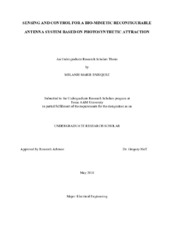| dc.creator | Enriquez, Melanie Marie | |
| dc.date.accessioned | 2018-05-23T15:32:58Z | |
| dc.date.available | 2018-05-23T15:32:58Z | |
| dc.date.created | 2018-12 | |
| dc.date.submitted | December 2018 | |
| dc.identifier.uri | https://hdl.handle.net/1969.1/166470 | |
| dc.description.abstract | This paper discusses the concept of replicating biological processes through the use of self-configurable antenna patterns. Through non-linear gradient descent methods and the use of parasitic beam forming, it is proposed that a configured antenna can replicate the photosynthetic attraction of a plant through selective power pattern reception. For characterization purposes, it is necessary to create a microwave tuning circuit to collaborate with an adaptive 2-element yagi- uda antenna network. The two-element network will be used to characterize the parameters for maximum power potential, which will precede the introduction of multiple parasitic array elements and the concept of a reactively controlled directional array. Through multiple beam forming of elements, the centralized antenna will be forced to differentiate between varying power patterns. Circuit tuning and electrical characterization will allow for the centralized antenna to have a self-configurable response mechanism and allow for the ability to position itself for maximum power reception. | en |
| dc.format.mimetype | application/pdf | |
| dc.subject | Parasitic Arrays, Antenna, Reconfigurable | en |
| dc.title | Sensing and Control for a Bio-Mimetic Reconfigurable Antenna System based on Photosynthetic Attraction | en |
| dc.type | Thesis | en |
| thesis.degree.department | Electrical & Computer Engineering | en |
| thesis.degree.discipline | Electrical Engineering | en |
| thesis.degree.grantor | Undergraduate Research Scholars Program | en |
| thesis.degree.name | BS | en |
| thesis.degree.level | Undergraduate | en |
| dc.contributor.committeeMember | Huff, Gregory | |
| dc.type.material | text | en |
| dc.date.updated | 2018-05-23T15:32:59Z | |


